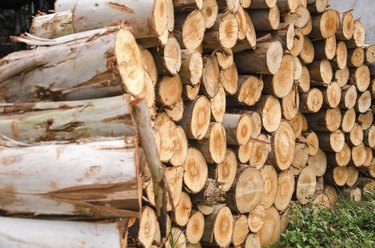
Eucalyptus lumber can come from any one of over 10 different species with such common names as blue gum, jarrah and swamp mahogany. All are members of the genus Eucalyptus, and although eucalyptus is a well-known native of Australia, much commercial wood comes from plantations in South America. The wood from some species, especially jarrah (Eucalyptus marginata), which grows in U.S. Department of Agriculture plant hardiness zones 9 to 11, is well-suited for outdoor building and requires the same basic care as other types of wood.
600 Species of Eucalyptus
Video of the Day
Eucalyptus is a broad genus with over 600 species, and most are indigenous to Australia, Tasmania and the surrounding islands. Some species have been exported to other countries, sometimes to the detriment of the local ecosystem. For example, Red River gum (Eucalyptus camaldulensis), which grows in USDA plant hardiness zones 9 and 10, is listed in the California Invasive Plant Inventory Database. On the other hand, the rainbow eucalyptus, hardy in USDA zones 10 and 11, has been a colorful addition to the Hawaiian ecosystem. The species that produce the best wood typically grow in tropical and sub-tropical regions.
Video of the Day
Common Types of Eucalyptus Wood
Robusta eucalyptus (Eucalyptus robusta), which is also known as swamp mahogany and grows in USDA zones 10 and 11, was introduced to Hawaii from its native Australia in the 1880s. It produces a strong, heavy wood useful for a number of outdoor and utility applications, including poles and pallets. Outdoor builders — especially in Australia — also often use jarrah, which is harder and darker than swamp mahogany. Blue gum (Eucalyptus globulus), which grows in zones 8 to 11, has an attractive blonde color, and it's even harder than jarrah, but it doesn't dry well and tends to warp, making it unsuitable for applications for which stability is a requirement.
The Need for Finishing
Manufacturers use both jarrah and swamp mahogany to make flooring boards, furniture, door skins and other interior woodwork items, and these typically require the same care as similar items made from a domestic hardwood, such as oak. Even though the eucalyptus wood has some moisture resistance, you should seal it, because changing humidity conditions can cause it to swell and shrink, which affects the stability of assembled floors, furniture and other woodwork items. Finishing also gives the wood a deeper color and a rich luster, and it also provides protection from insects and rot.
Maintaining Outdoor Furniture
When eucalyptus wood is used for outdoor projects, such as patio furniture or outdoor structures, it's even more important to seal it to protect it from moisture. Clean the wood to remove dirt and mold before sealing. Scrub the wood with a soft-bristle brush using a solution of 1 Tbsp. bleach and 5 Tbsp. dish soap mixed into a gallon of water. Dry the wood with towels and allow it to completely dry before applying the sealer. You need a product intended for exterior wood, such as polyurethane or spar varnish, and you should apply two to three coats. Allow the sealer to dry for approximately two hours between coats.
Keep standing water off your eucalyptus-wood furniture, and keep the furniture out of direct sunlight, which breaks down the surface layer of wood fibers and causes discoloration and finish failure. Your outdoor eucalyptus furniture will last longer and remain in better shape if you cover it with a vinyl tarp whenever you aren't using it.